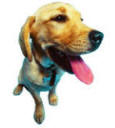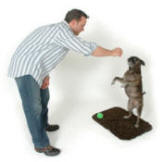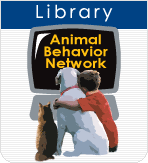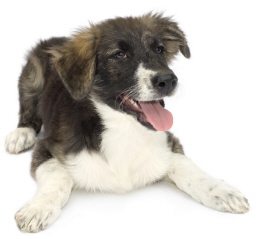|
Need Help?
|
|
Call
1-800-372-3706
to
speak to a Veterinary Behavior Technician |
|
Paws To Speak!
Member
Main Menu
|


Pet Professional Tip
Note: Problems
with a clicker in group settings such as a
veterinary practice or home with multiple pets.
All pets hear the clicker even if you are targeting
one. Over time, if a
reinforce (food, toy, praise, etc.) does not
follow the click, learned behaviors will most likely
decay and then stop.


|
 |
|
Help is at your
fingertips by library, email and
phone. |

Click on
Library Icon
to learn more
|
What is a Clicker
The clicker
is a small plastic box with a
metal strip that makes a sharp,
clicking sound when pushed and
released. One value of the
clicker is the unique sound that
doesn't get lost. Verbal
cues can be lost as "Blah, blah,
blah" if we say too much instead
of limiting communication to
specific words only. If you
carry a clicker, you can give
immediate feedback that means,
"A treat is coming." People
often forget to give immediate
praise. Carrying a clicker
is a good reminder to click when
the dog is being good. Clickers
also deliver better precision
and clarity in reinforcing a
desirable behavior.
Saying, "Yes"
or "Good" gives clear
and precise praise better than
saying," Good dog!"
In
behavior modification terms, you
are "pairing" the clicker with a
strong reinforcer.
Any behavior that the dog begins
to pair with a "reinforcer" -
something the dog really wants -
is more likely to be repeated.
When clickers are used
correctly, they are powerful
tools for training and shaping
desirable pet behaviors.

Click and Reward
Clicker training is one form of
positive reinforcement training.
The dog does a behavior you
want, you immediately click, and
then give the dog something he
values such as a tasty treat. This
is a GREAT tool for the dog that
is difficult to lure into a
"down" position!
Introducing
the Clicker
To get started,
teach the dog that one click means a treat is on the
way. Show the clicker to the dog then click and
deliver a treat. Repeat this sequence a few times in
a row until the dog begins to look for the treat
when he hears the click. Then you are ready to use
the clicker to communicate to your dog what
behaviors get rewarded.
The easiest
reinforcer is a tasty food treat but if your dog is
not motivated by food (not even before meals when
very hungry) then you may need to use a different
reward such as tossing a ball or a favorite toy or
offering a chew that is not available at other time.
The clicker must become the magical treat delivery
machine.
|
Research has shown that any
animal—whether a dog, cat,
dolphin, parrot, fish,
horse, or human—is more
likely to learn and repeat
actions that result in
consequences he values. |
Now you are ready to
watch the dog carefully for natural behaviors that
you can predict and want your dog to repeat more
often such as sitting, laying down, going potty in
the preferred location or resting quietly on his
mat, or chewing on the correct item. While the
dog is performing this good behavior, click, praise,
and deliver something the dog values and never gets
for free.
Cause and Effect
Dogs develop
confidence and are calmer when they have control
over the consequences of their actions. They are
also enthusiastic because they anticipate enjoyable
consequences.
|
Simply
put, an animal tends to
repeat an action that has a
positive, predictable
consequence. |
Shaping Behaviors
To
shape a new behavior, such as
"shake hands" use the clicker to
reinforce baby steps that move
the dog closer and closer to the
actual behavior you want. For
example, if you want to teach
your dog to "shake" begin by
clicking and treating if he
simply raises his paw just a
little. As the dog lifts
the paw higher, up the reward
and praise. Eventually, you will
only reward the higher raises of
the paw. Continue in small steps
so the dog does not get
discouraged and give up. Once
the dog understands what is
being rewarded, you can
begin to reach for the paw, say
shake, and click. Only click
when the dog does not withdraw
the paw as you reach. Your reach
is becoming a new cue. Dogs
always learn the body language
or hand signal before they learn
the verbal cue. Breaking the
behavior down into little steps
helps the dog learn more quickly
how to do what it is you want.
Behaviors that animals do
naturally can be taught by following four simple steps:
-
Identify the behavior you want then watch the pet so you can
reinforce the behavior by delivering something the pet values
while still doing the behavior. For example, when the dog lies
down, you give the dog a chew. Once the dog begins to look at
you for reward, then try the lure.
-
Use food to
lure the pet into the desired position such as
"sit" and "down" then reward with food.
-
Mark
desirable behaviors with an immediate, unique sound that is
followed by a reward. When the dog lies down, click, then get
the dog a food treat.
-
Reinforce desired behaviors with immediate rewards that the
dog
really
wants.
|